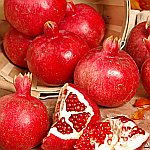|
|
|
Pomegranate Fruit Facts Page Information
|
Availability by variety
|
 Pomegranate fruit is native from Iran to the Himalayas in northern
India and was cultivated and naturalized over the whole Mediterranean region
since ancient times. It is widely cultivated throughout India and the drier
parts of southeast Asia, Malaya, the East Indies and tropical Africa. The
tree was introduced into California by Spanish settlers in 1769. In this
country it is grown for its fruits mainly in the drier parts of California
and Arizona.
Pomegranate fruit is native from Iran to the Himalayas in northern
India and was cultivated and naturalized over the whole Mediterranean region
since ancient times. It is widely cultivated throughout India and the drier
parts of southeast Asia, Malaya, the East Indies and tropical Africa. The
tree was introduced into California by Spanish settlers in 1769. In this
country it is grown for its fruits mainly in the drier parts of California
and Arizona.
The Fruit, nearly round, 2-1/2 to 5 in. wide, is crowned at the
base by the prominent calyx. The tough, leathery skin or rind is typically
yellow overlaid with light or deep pink or rich red. The interior is separated
by membranous walls and white, spongy, bitter tissue into compartments packed
with sacs filled with sweetly acid, juicy, red, pink or whitish pulp or aril.
In each sac there is one angular, soft or hard seed. High temperatures are
essential during the fruiting period to get the best flavor. The pomegranate
may begin to bear in 1 year after planting out, but 2-1/2 to 3 years
is more common. Under suitable conditions the fruit should mature some 5 to 7
months after bloom.
The fruits are ripe when they have developed a distinctive color and
make a metallic sound when tapped. The fruits must be picked before over
maturity when they tend to crack open, particularly when rained on. The
pomegranate is equal to the apple in having a long storage life. It is best
maintained at a temperature of 32° to 41° F. and can be kept
for a period of 7 months within this temperature range and at 80 to 85%
relative humidity without shrinking or spoiling. The fruits improve in storage,
becoming juicier and more flavorful.
Detailed nutritional informatin can be found by searching the
USDA Nutritional Database
. Enter "Pomegranate" (no quotes) as the keyword and select the link
and report of interest.
Scientific classification: Pomegranate belongs to the family Punicaceae.
It is classified as Punica granatum.
|
|